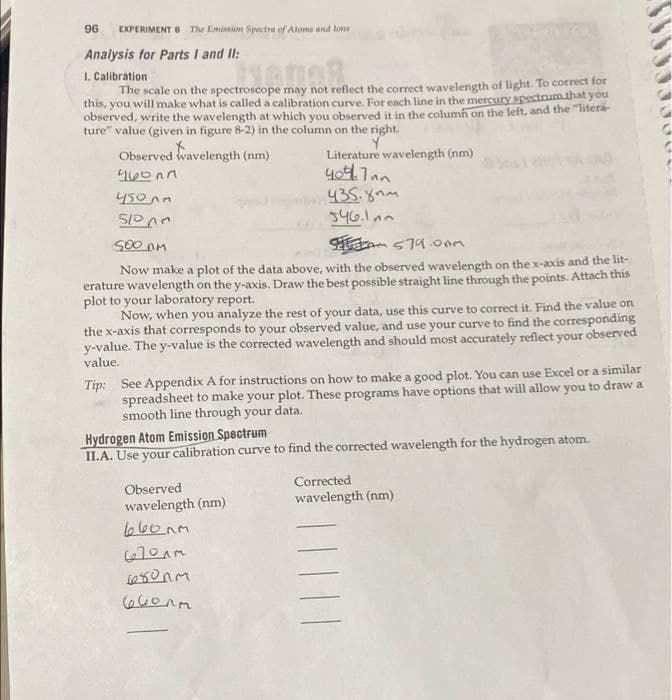Hydrogen Atom ILA. Use your calibration curve to find the corrected wavelength for the hydrogen atom Corrected wavelength (nm) Observed wavelength (nm)
Hydrogen Atom ILA. Use your calibration curve to find the corrected wavelength for the hydrogen atom Corrected wavelength (nm) Observed wavelength (nm)
Principles of Instrumental Analysis
7th Edition
ISBN:9781305577213
Author:Douglas A. Skoog, F. James Holler, Stanley R. Crouch
Publisher:Douglas A. Skoog, F. James Holler, Stanley R. Crouch
Chapter8: An Introduction To Optical Atomic Spectrometry
Section: Chapter Questions
Problem 8.8QAP: The Doppler effect is one of the sources of the line broadening in atomic absorption spectroscopy....
Related questions
Question

Transcribed Image Text:96
EXPERIMENT 0 The Emission Spectra of Aloms and lons
Analysis for Parts I and II:
1. Calibration
The scale on the spectroscope may not reflect the correct wavelength of light. To correct for
this, you will make what is called a calibration curve. For each line in the mercury spectrum that you
observed, write the wavelength at which you observed it in the columh on the left, and the "litera-
ture" value (given in figure 8-2) in the column on the right.
Literature wavelength (nm)
404.7nn
435.8nm
546.1nm
Observed wavelength (nm)
450nm
am s74 onm
Now make a plot of the data above, with the observed wavelength on the x-axis and the lit-
erature wavelength on the y-axis. Draw the best possible straight line through the points. Attach this
plot to your laboratory report.
Now, when you analyze the rest of your data, use this curve to correct it. Find the value on
the x-axis that corresponds to your observed value, and use your curve to find the corresponding
y-value. The y-value is the corrected wavelength and should most accurately reflect your observed
value.
Tip: See Appendix A for instructions on how to make a good plot. You can use Excel or a similar
spreadsheet to make your plot. These programs have options that will allow you to draw a
smooth line through your data.
Hydrogen Atom Emission Spectrum
II.A. Use your calibration curve to find the corrected wavelength for the hydrogen atom.
Corrected
Observed
wavelength (nm)
wavelength (nm)
Expert Solution
This question has been solved!
Explore an expertly crafted, step-by-step solution for a thorough understanding of key concepts.
This is a popular solution!
Trending now
This is a popular solution!
Step by step
Solved in 3 steps with 1 images

Knowledge Booster
Learn more about
Need a deep-dive on the concept behind this application? Look no further. Learn more about this topic, chemistry and related others by exploring similar questions and additional content below.Recommended textbooks for you

Principles of Instrumental Analysis
Chemistry
ISBN:
9781305577213
Author:
Douglas A. Skoog, F. James Holler, Stanley R. Crouch
Publisher:
Cengage Learning

Principles of Modern Chemistry
Chemistry
ISBN:
9781305079113
Author:
David W. Oxtoby, H. Pat Gillis, Laurie J. Butler
Publisher:
Cengage Learning

Chemistry: The Molecular Science
Chemistry
ISBN:
9781285199047
Author:
John W. Moore, Conrad L. Stanitski
Publisher:
Cengage Learning

Principles of Instrumental Analysis
Chemistry
ISBN:
9781305577213
Author:
Douglas A. Skoog, F. James Holler, Stanley R. Crouch
Publisher:
Cengage Learning

Principles of Modern Chemistry
Chemistry
ISBN:
9781305079113
Author:
David W. Oxtoby, H. Pat Gillis, Laurie J. Butler
Publisher:
Cengage Learning

Chemistry: The Molecular Science
Chemistry
ISBN:
9781285199047
Author:
John W. Moore, Conrad L. Stanitski
Publisher:
Cengage Learning

Chemistry & Chemical Reactivity
Chemistry
ISBN:
9781133949640
Author:
John C. Kotz, Paul M. Treichel, John Townsend, David Treichel
Publisher:
Cengage Learning

Chemistry & Chemical Reactivity
Chemistry
ISBN:
9781337399074
Author:
John C. Kotz, Paul M. Treichel, John Townsend, David Treichel
Publisher:
Cengage Learning
